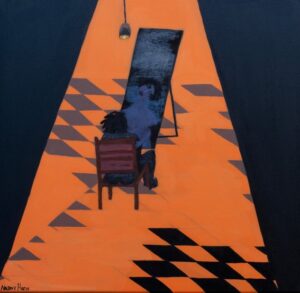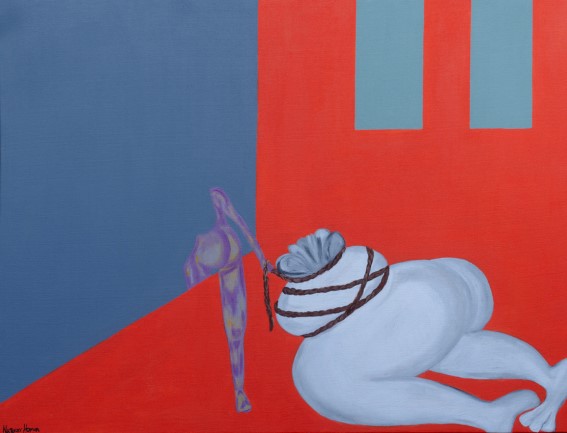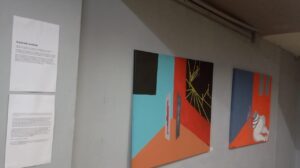
Najaax Harun does not offer easy reflections. She offers portals. Her work is an invitation to stare into the mirror until it dissolves, until the frozen self, heart finally open, thaws and steps through.
Joy Odondi Mala writes on the Somalian artist Najaax Harun
Najaax Harun, The dark night of the soul, 2024. Acrylic, Charcoal with Oil Pastels, 61 x 61 cm. Image courtesy of the artist and Munyu.
Najaax Harun
On Owning a Body When The Sun Sets On The Inherited Self
“Shush, don’t tell Hooyo/mom”
I had to learn
How to transform this body
To something I alone own
Sometimes
When the sun is about to set
Towards the late horizons
And the chaos of the city
Descends behind the buildings
I can feel my mother’s eyes
Slowly penetrating my bones
I can hear her whisper
How dare that I took
Something only she could own
Najaax Harun
A mirror does not lie; it can dissemble. In the haunting space of Najaax Harun’s paintings, it often does. The painting that first arrested me and has since refused to release its grip, ‘The dark night of the soul, 2024’, depicts a woman in a moment of private reckoning, confronting a reflection that is both hers and profoundly other. Their figures, rendered in spectral, distorted forms, float within an abstracted domestic void. Light in this intimate chamber is felt rather than clearly seen: it bleeds from the warmth of orange floors and pools in the mirror’s surface, which itself seems to defy its own physicality. A hand from the reflection rests upon the subject’s shoulder, a gesture that is less a caress than an elemental merging, an attempt to communicate care through the silent language of touch.
This mirrored double returns the subject’s look with an expressive, knowing gaze. She observes the differences that delineate them; the fissures between self and image, between being and becoming, and meets them without judgment. It is a quiet, unsettling acceptance. This suspended moment is the core of Harun’s power. It visualizes the psychic gap that exists after one acquires a new freedom but before one has learned to inhabit it; the lingering, liminal pause before embodiment of newness, before the self-sheds its old skin to become something else, something almost unrecognizable, and yet truly its own.
I encountered this piece in March of this year at a group exhibition at Munyu following an airbrush residency by BrushTu. The exhibition, ‘Progressions,’ was co-curated by Rose Jepkorir and Melanie Manosi and invited contemplation on progression, movement, the passage of time, and memory. Dismiss my apophenia when I insist that the showing and validation of such uniquely deep work that transcends this reality’s parameters had to be at Munyu. As a space that defines itself as a “sheltering/space for theoretical and practical forms generated by artists and affiliating practices,” Munyu provides a crucial platform for emerging artists like Harun, offering a viable alternative to traditional art institutions and fostering the kind of experimental, lifelong practice her work exemplifies. It was within this supportive yet critically engaged environment that her paintings first commanded a wider audience.
Najaax Harun is an artist whose practice is a deep and unflinching excavation of the cultural and personal dimensions of emotion, representation, and memory. That her work feels so visceral, so fully formed, makes it surprising to learn that her encounter with the institutional art world was not until she was in her mid-20s. In our conversation, she said that a trip to an Addis Ababa gallery in her early twenties was a point of fascination, but not yet a revelation. The catalyst arrived later through her own necessity for expression. Born in Hargeisa in the aftermath of Somalia’s civil war, she inherited a collective psyche marked by trauma. The energy that Najaax had experienced in the world had to come out through her. This energy first found its outlet in poetry and prose, a retreat into the creative. The pivot to painting came via a gift: a friend’s gift of a painting set. In it, she discovered a medium that could give voice to all that words could not contain and a belonging; a way to talk back, and a way to hide in plain sight.
Najaax Harun, Heavy shadows, 2024. Acrylic with Charcoal, 77 x 102 cm. Image courtesy of the artist and Munyu.
This negotiation of visibility and concealment charges her work with a raw, magnetic energy. Her paintings pull you in across a room with their vibrant, almost violent, color fields of oranges that glow with interior heat, reds that signal both wound and vitality, blues that are depths and bruises. You move closer, compelled by a curiosity that quickly becomes a confrontation.
Harun trains this formidable expressive force primarily on the women of her society, subjects she paints with a deliberate, defiant honesty. There is a lot of flesh in her work, and it is not all curated to be beautiful. She strips away the obligatory performance of beauty to ask a more urgent question: what remains of a woman when that demand is taken off the table? My answer is everything. Everything raw, powerful, vulnerable, and complex.
She lends us their eyes, and through them, we are forced to see the architecture of constraint: the cultural setbacks of upbringing, the narrow horizons of “acceptable” futures, the constant negotiation of autonomy. We become a woman who, in many cases, is forced to comply for mere survival, often at the expense of her life. And simultaneously, we are the woman who chooses another dimension of existence. A woman who is determined to become, and the one who insists on the dignity of that becoming.
Installation view, ‘Progressions’, Munyu, 2024. Image courtesy of Munyu.
Without formal arts institutions around her, Harun’s education was one of self-determination, pieced together from the digital archives of online tutorials. This autodidactic path is perhaps why her work feels so untethered from established parameters, as it echoes the transcendental vision of modernism but is filtered through a deeply personal, contemporary experience. Her figures exist both within and beyond their bodies, within and beyond the room, within and beyond a single narrative.
Since her resonant showing in the group exhibition “Progressions”, Harun’s trajectory has been ascendant, with presentations at the Basel Social Club, Catinca Tabacaru, and the French Institute in Timisoara. Her works are now part of the esteemed collection of the KADIST Art Foundation, a testament to their immediate and powerful impact.
Najaax Harun does not offer easy reflections. She offers portals. Her work is an invitation to stare into the mirror until it dissolves, until the frozen self, heart finally open, thaws and steps through.
“You only see what your eyes want to see”
How can life be what you want it to be?
You’re frozen
When your heart’s not open”


